24 March 2016
Alexander Shcherbakov
<-! htc banner -> 
Today, let’s talk about the Android operating system on personal computers. For example, consider Remix OS and discuss the questions: who want Android on a computer, how it works and whether it is necessary
Introduction
Android everywhere. On smartphones , plates, clocks, computers, televisions and even cars. On smartphones and tablets running its standard version, created for Android Wear watches, on a TV set manufacturers Android TV, in cars – Android Auto, but a specially adapted version for personal computers do not. According to Google’s policy, rather than a customized version of Android on your PC you have to use Chrome OS.

Modern “typical” user most of the time in the browser, it’s not a secret. Picking up this trend, Google, and took up the development of Chrome OS. I think about all understand what a Chrome OS: This OS for personal computers, in which web services take precedence over the usual applications and functions. In this system, the main tool for interaction with the user is a browser. With the usual Android it has little in common: a separate application store, the stripped-down functionality without the Internet and focus on managing the keyboard and mouse (touchpad). Of course, Chrome OS does not allow to use the computer for professional activities, whether it be video editing, photo editing, coding, and so on, and most selling devices on the system are very unpretentious characteristics, except for the Chromebook Pixel.

Let’s talk about rethinking the Android desktop to the example Remix OS . The system is being developed by Jide Corporation and is based on the Android-x86. In addition to software development, they organized a pretty successful kraundfandingovuyu company on Kickstarter site: to create your own mini-PC based Remix OS they managed to collect more than 1.5 million dollars, although it was initially planned total of 50 000 $ . Quite revealing.
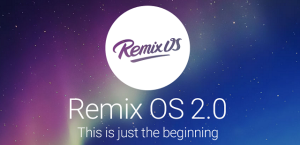
In the middle of January this year the team Jide Corporation released the second version of its system called Remix OS 2.0, now it is based on Android Lollipop. It should immediately be noted that this is only beta for developers and enthusiasts, do not yet consider it as an alternative to their “working” of the operating system, it takes time. At the time of writing the text (March 2016) is the latest version of Remix OS 2.0.102, be careful if you are reading this much later, the information may be irrelevant.
Install
If you still consider yourself enthusiast, then installing Remix OS 2.0.1, you will need a personal computer on the x86 architecture, flash card USB 3.0 interface with a minimum memory capacity of 8 GB and a little free time. Note that these requirements are advisory in nature, but the quality of your external drive, which will be installed image that will directly affect the performance and speed of the system. I want to please the owners of old laptops with 32-bit processors: a version Remix OS for these processors, the system can help to “revive” the device and make it a simple media player
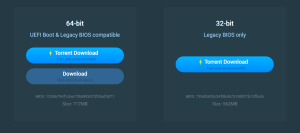
First you need to download the system image from the official site of the developer. The site is completely in English, but to find a button to download work does not make the correct version. In the downloadable archive you will find three files: an instruction program to burn the image to the drive and the system directly to the image itself.
process of recording an image on a flash drive as simple as possible:
- Plug the drive;
- Run Remix OS Installation Tool;
- Specify the path to the ISO-file;
- Choose the media;
- You press “OK” .
Be careful with this procedure will erase all data from your card. After reports that the file is recorded, you need to restart your computer. Depending on what your BIOS, Legacy (old device) or UEFI (a modern unit), the next step may be different. In the first case you need to call when the boot menu by using a special key (F12 for Dell computers, F9 for HP, F12 for Lenovo, F11 for MSI, Option Key on the Mac) and select the drive with the installed system. If you have a more modern UEFI BIOS, then you first need to enter the BIOS settings and disable it para Secure Boot (translated into the state disabled), the exact location of the item on the menu, I give you I can not, because it depends on the installed BIOS – looking for information on the Internet
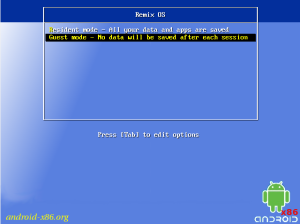
After booting the system from a USB drive appears window with a choice of operating modes:
- «guest mode» – the so-called “guest” mode or Live CD, in which you work without storing all the data, with each new start of this mode the system will boot as for the first time
- «Resident mode» -. the usual mode of operation of the operating system, when all the information is stored for later launch. This mode is best to use a flash drive with USB 3.0 interface, otherwise the download will take a very long time.
This is not the only way to install. You can install the system parallel to the other on your hard drive and work in dual-boot mode when turning on the computer will ask which of the two systems run. Special need in this, as long as Remis OS is not very stable, and to work on a regular basis simply does not fit, but still tell you a fairly simple way of parallel installation. For this, I will send you to 4pda forum for utility YourDroid. It makes it easy to install the system on the Android-x86-based, and then it is just as easy to remove.
But this is not the last way. Remix OS easily placed on a virtual machine, but it requires quite a big performance from your computer
First impression:. Setting interface

The system will suggest when you start to pass the initial configuration. We must read and agree to the license agreement, select the system language, the first choice are English (United States) and, apparently, two different Chinese dialect, but do not worry, then in the settings you can select not only Russian, but also many other languages .
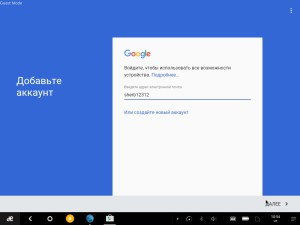
After the successful launch Remix OS 2.0 comes the next question – installation of Google services. This requires a download and install the apk-file at the following link, pre-security settings you want to allow installation of applications from unknown sources. The installation process is apk-file does not differ from that on your tablet or smartphone. You can also find a ready-made assembly Remix OS from Google preinstalled services and Root-rights, then I’ll link will not give, because the system is constantly updated – you can use the search

Now you can contemplate a fully functional system with the app store. Most applications work properly and runs, only the main problems in the adaptation of the application when the window is resized. By the way, in contrast to the usual Android, Remix OS provides the ability to work in multi-mode for example, Windows 10 or Mac OS, when you can have on the screen at the same time a lot of windows to change their size and location. In some applications support drag-and-drop, that is, war or text files between applications.

in the image of Windows 10. respects Remix OS 2.0 interface is made on this point to the lower status bar to open applications, an analog” start “in the lower left corner and the notification bar that appears on the side. From the control panel, you can see the battery level (if you have a laptop or tablet), enable / disable Bluetooth and set up an Internet connection.
You can post links to applications and folders on the desktop, and there is the usual for many “adult” operating systems cart. One thing is not clear – why not make it possible to place on the desktop widgets, it’s a fairly obvious use for them. Instead, the “start-up” can be found “Widgets Of” application, when it starts to open a separate panel on which you can post widgets, and they will only be available when you open this app – pretty uncomfortable
Work. and interaction with the system
All the vital devices connect themselves and do not require installation of drivers and other dances with a tambourine, whether keyboard, mouse, touchpad, flash card, or other peripherals. But it should be noted that the system is not implemented switching languages familiar keyboard shortcut Alt + Shift. To work correctly, language switching can advise you to use the solution on the forum 4pda. By the way, many other combinations of keys and individual team work here: Ctrl + V, Ctrl + C, Ctrl + A, Ctrl + N, Ctrl + S, etc.
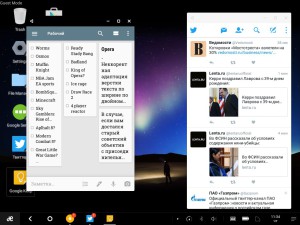
The user experience Remix OS with a keyboard and a mouse is almost indistinguishable from that in Windows. We need only consider that in many applications interface adapted for touch control and many gestures to be performed with the mouse, and very little action with the right mouse button, it is almost never used.

Pre suite of applications is very poor: it is a file manager, MX Player, browser, Calculator, clock and simple audio player. Installation services Google provides an opportunity to raise any applications from the Play Market, without it, the system is almost useless for the “normal” user. You can, of course, download the apk-file at the source, but it is not always convenient. In store you can download a set of your desired software: office suite, clients of social networks and e-mail, music and video players, games, and so on. As for the game, then all is ambiguous: many simply inconvenient to manage with the mouse, and some may not start
From the obvious drawbacks, in addition to not very stable operation of the system as a whole, I can say not very convenient to work on the Internet, so as many browsers for Android is not adapted to the long diagonal and mouse control. In addition, some sites refuse categorically to download the desktop version of opening the mobile version. But for many sites and web services have analogues in the form of apps on Google Play, which work, in general, not bad.
To sum up
The system is quite ” raw “and has the status of beta, but we can roughly determine the target audience – it is primarily enthusiasts and those who purchase a device companies Jide Corporation. Remix OS can not be focused on user-inhabitant average, as many will be very difficult to re-learn and get used to the new system, in spite of its simplicity and “user-friendliness”, this will require some kind of third person – the person who installs the system, configure and explain the “inexperienced “man, how to handle it. I do not think it (the system) will be able to gain popularity, but some potential she certainly has.
We will closely monitor its development and to wait for the full release. I ask you, dear readers, to share your opinion about this system.
Thank you for your attention.
No comments:
Post a Comment